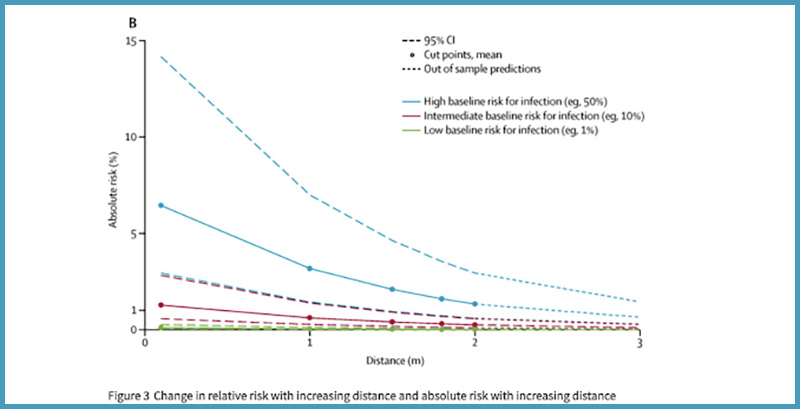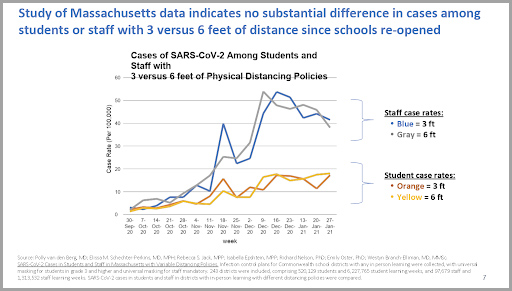Bailey: What’s the Difference Between 3 and 6 Feet When it Comes to COVID-19 Spread? Not So Much, New Summary of 130 Studies Shows

The Centers for Disease Control and Prevention removed a significant hurdle for reopening schools with updated guidance for socially distancing students within schools. Under the new framework, students can be spaced at least 3 feet apart in elementary schools. Middle and high school students could be spaced at least 3 feet apart in communities with lower community transmission but should resort back to the 6-foot standard in communities with higher transmission.
American Federation of Teachers President Randi Weingarten issued a statement in response, saying, “While we hope the CDC is right and these new studies convince the community that the most enduring safety standard of this pandemic — the 6-foot rule — can be jettisoned if we all wear masks, we will reserve judgement until we review them, especially as they apply in districts with high community spread and older buildings with ventilation challenges.”
However, these are not new studies so much as an accumulating body of research that has been amassed over the last year. Our recent report summarizing more than 130 studies on schools and COVID-19 touches on some of this research, including a study conducted in 1941 that set the 6-foot distancing standard. Researchers found that the tiny droplets exhaled when people talk generally fall to the ground within 6 feet. But more recent scientific evidence suggests that 3 feet can provide adequate protection from SARS-CoV-2infection, particularly when other protective measures — most importantly, masks — are employed.
One seminal evaluation of 172 studies from 16 countries showed that physical distancing of at least 1 meter (3 feet) along with mask wearing was associated with a 75 to 85 percent reduction in the risk of infection. There is some additional reduction in likelihood of transmission from 3 feet to 6 feet in low-risk settings (such as a school requiring universal mask wearing, having enhanced ventilation and other mitigation measures), but it is relatively minor in comparison.
The important question raised is whether the minor reduction of risk from 6 feet outweigh the costs in terms of making it difficult to bring more students back to school.

The answer for a number of scientific bodies has been: no. The American Academy of Pediatrics (AAP), World Health Organization, National Academies of Sciences Engineering and Medicine and Harvard T.H. Chan School of Public Health have recommended for months now that 3 feet of distancing can provide adequate protections when combined with other measures.
France, Ireland, Italy, Portugal, India and Norway are among the countries to have adopted 1 meter (3 feet) of distancing for their school reopenings. In justifying the change in guidance, the CDC noted that studies from Switzerland, Australia, Italy, the U.K. and Germany found limited transmission for K-12 schools that were using the 1-meter distance between students.
Massachusetts, Indiana and Virginia also allowed for 3 feet of spacing in the fall and did not see any surge of cases or hospitalizations compared with states that used the more conservative 6 feet standard. A new study published in the journal Clinical Infectious Diseases compared infection rates at Massachusetts schools that required at least 3 feet of distancing with those that required at least 6 feet. They found no significant difference in the coronavirus case rates among students or faculty.

A paper published March 20 provided additional details on a study of 17 rural Wisconsin K-12 schools that had full in-person instruction and found only seven cases among students that were linked to in-school spread. The new paper showed that 90.7 percent of elementary school students were seated less than 6 feet from each other and only 9.3 percent were distancing 6 feet or more. In secondary school classrooms, 86.2 percent of students maintained at least 6 feet of distance, 7 percent maintained between 3 and 6 feet and 6.8 percent less than 3 feet.
One consistent finding among these studies is the importance of other protective measures, particularly masks, with respect to evaluating the risks and benefits of distancing. Unpublished research from the Mayo Clinic shows exposure risk is nearly 100 percent if a person is not wearing a mask within 1 foot of an infected person. That risk drops to just 3 percent if the distance is increased to 6 feet. However, if masks are used, the risk exposure is essentially the same at 1 foot, 3 feet and 6 feet.

Another study from August explored risk based not just on distance, but also the amount of contact time, wearing of masks and type of activity taking place in the room. The result is a more nuanced model of risk, helping to put the social distancing in context. A scenario where more masked students are indoors in a well-ventilated room carries lower risk than one in which students are spaced out in a well-ventilated room while singing or shouting.

The academy says, “Schools should weigh the benefits of strict adherence to a 6-feet spacing rule between students with the potential downside if remote learning is the only alternative.” Faced with these tradeoffs, more education leaders are adopting the 3-foot standard. Illinois adopted it as a recommendation for all the state’s schools. The City Schools of Decatur, an Atlanta-area district serving families of many CDC scientists, announced it will adopt the 3-foot standard to accommodate more in-classroom learners. “I do think if people are masked it is quite safe and much more practical to be at 3 feet,” said one nation’s leading infectious disease scientists in July 2020. That scientist was Rochelle Walensky, now director of the CDC, in a response to a question asked by her mayor.
The updated CDC guidance is welcome and long overdue, given the consensus that was appearing as early as last summer. The biggest challenge with reopening schools has not been a lack of studies in how to safely do so, but instead guidance lagging the growing body of research.
John Bailey is an adviser to the Walton Family Foundation and a visiting fellow at the American Enterprise Institute. He previously served in the White House and U.S. Department of Education. He worked on pandemic preparedness at the U.S. Department of Commerce in 2006.
Disclosure: The Walton Family Foundation provides financial support to The 74.
Help fund stories like this. Donate now!

;)
